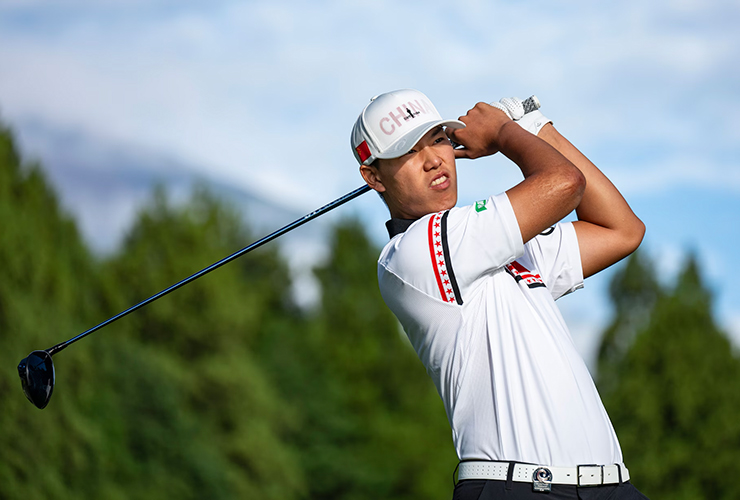No amateur golfer has ever been at a crossroads quite like the one China’s Wenyi Ding, a rising star at Arizona State and former U.S. Junior champion, found himself in this past summer. That’s because the DP World Tour’s Global Amateur Pathway—a stepping stone to the European circuit and the equivalent of the PGA Tour University—didn’t exist until this year.
In June, the DP World Tour, R&A and PGA Tour jointly launched the program, which offers the best eligible non-collegiate male amateur within the top 20 of the World Amateur Golf Ranking (WAGR) a DP World Tour card for the following season. It was model off the PGA Tour U. Ranking, which launched in 2020 and awards the top-20 college seniors after the conclusion of the college season membership on the PGA Tour (No. 1), Korn Ferry Tour (Nos. 1-10), and PGA Tour Americas (Nos. 6-20).
The Global Amateur Pathway eligibility criteria, though, is where Ding had to make a major career decision. Entrants must be at least 20 years old by the end of the calendar year; Ding reaches that age in November.
More importantly, pathway hopefuls must “not be a current NCAA Division-I player.” But Ding had enjoyed a stellar freshman season in 2024 at the former school of Jon Rahm and Phil Mickelson. Ding posted four top-five finishes in eight tournaments including a record-setting win at the Amer Ari Invitational in just his second event for the Sun Devils. That led to first-team All-American honors. Entering his sophomore campaign in the fall, Ding was projected to be among the top college players this season.
After the pathway announcement, Ding won the Southern Amateur in Kentucky and, at No. 4 on the WAGR, he was catapulted to the top of the pathway rankings. He currently leads over Denmark’s Jacob Skov Olesen. The pathway window finishes Oct. 13.
Which led to the fork in the road: leave Arizona State before this fall, and turn pro towards the end of the year, or stay in college?
“I was really struggling to choose this one,” Ding told Golf Digest at this week’s Asia Pacific Amateur Championship in Japan, an event run jointly by Augusta National and the R&A which offers the winner a start in the 2025 Masters and Open Championship. “I talked a lot with my coaches, with my friends, my agent. I think it’s really hard to get a [tour] card for a young player. This was probably the only chance [at the pathway], and I should take it.”
Adding to the stress of the decision was knowing that if Ding were to win the Asia Pacific Amateur at the iconic Taiheiyo Club—where he is the best-ranked player in the 120-player field—his commitment to turning pro would mean forfeiting the Masters and Open starts. But that’s all hypothetical.
“Yeah, it was difficult, but I can’t sacrifice [DP World Tour status] to wait for the Masters [and Open],” Ding said. “I know it’s a great [opportunity] for an amateur player, but I’m going to turn pro. [Hopefully], I can get in [those two majors] by myself. [I want to] learn how to be a professional player and keep improving. I want to try to make the cut at every tournament and, if I have a chance, try to win.”
It’s worth noting that amateurs joining the paid ranks at the expense of major exemptions is not uncommon. South Africa’s Christo Lamprecht, a former Georgia Tech star and World No. 1 amateur, won the British Amateur in 2023. After taking up his 2024 Masters invitation, the 6-foot-8 golfer turned pro in May and waived a U.S. Open exemption.
The Asia Pacific Amateur is being played for the 15th time and has helped introduce golf fans to top players before their professional success. Hideki Matsuyama, who won the Masters in 2021, is a two-time APAC champion.
This week’s edition is being held at the Taiheiyo Club in Gotemba, at the foot of Mount Fuji. It is the annual host course for the Japan Tour’s Taiheiyo Masters, whose past winners include Seve Ballesteros and Greg Norman. The course’s 18th green was also the site of Tiger Woods’ chip-in eagle that allowed he and U.S. teammate David Duval to join a playoff at the 2001 WGC World Cup.
“The back nine here is unbelievable,” Ding said of the hilly, tree-lined course.
Ding reveres the Asia Pacific Amateur and wants to sign off on his career by winning, even if he can’t enjoy the spoils of the victory. He was runner up last year after a playoff loss to Jasper Stubbs at Australia’s world-renowned Royal Melbourne.
“I feel really good to play this tournament and to play in Japan,” Ding said. “I prepared a lot. I think I should do better than last year. It’s a good chance for finish off my amateur career.”
Main Image: Graham Uden









